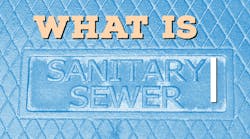Salt Lake City, Utah, is the home of the Central Valley Water Reclamation Facility (WRF), a modern 65-mgd wastewater treatment plant that uses the trickling filter/solids contact process. Like many other facilities across the country, Central Valley is continuously challenged to meet the expanding water treatment demands of a growing residential and industrial community.
With this growth came a vexing problem for the plant.
"We were experiencing more and more large objects coming into the headworks of our plant," said Dan James, maintenance manager of Central Valley WRF. "There were huge grease balls, sticks, rocks, wood two-by-fours and every kind of garbage. We were constantly dealing with plugging of our conveying system that handles the screenings and major problems with our downstream equipment."
That's when the plant called in Franklin Miller for a solution, and a heavy-duty Taskmaster TM1630 screenings grinder was purchased. The unit was strategically placed between the discharge of the screens and the inlet hopper of the vacuum screenings conveying system. The grinder employs a twin-shaft shredding mechanism with two banks of intermeshing cutters that easily grind even large screenings solids down to a size readily handled by the system.
At Central Valley WRF, the shredded output is discharged from the grinder, transported to another level and hauled to a landfill for disposal.
Handling heavy solids
The Taskmaster TM1630 is a heavily constructed 10-hp grinder suitable for handling heavy solids accumulations. This unit employs 23⁄4-in. hardened hex shafting, mechanical seals, direct inline gear drive, and special cleaning combs that ensure the cutting chamber is kept clear. A model S260 Automatic Reversing Control reverses the unit in case of a jam condition.
According to James, the unit has operated perfectly to stop the plugging in the screenings conveyance piping and has been instrumental in protecting downstream equipment.
The grinders are powerful and versatile units that can shred heavy solids in both gravity and liquid systems. The units can be installed horizontally with a stand, hopper or flange adapter, or vertically for channel or pipeline applications. Typical applications include gravity and conveyor-fed sewage screenings, in-channel raw sewage, correctional institution effluent, documents, product rejects and returns, garments, filters, bottles and
containers, plastics, turnings, packaging, wood, paper and more.
The grinder can be supplied with high profile cutters for grabbing solids that roll on others or with ultra-fine cutters that finely reduce wastewater solids to a size easily handled by downstream equipment. Units are available in stainless steel construction in addition to standard alloy steel and iron body construction. Available input sizes range from 16 x 20 in. up to 16 x 60 in.
Recently, James received a call from another wastewater facility with almost the identical problem. He spoke to the engineer and highly recommended the Taskmaster.
"I told them that it does everything we need," James said.

